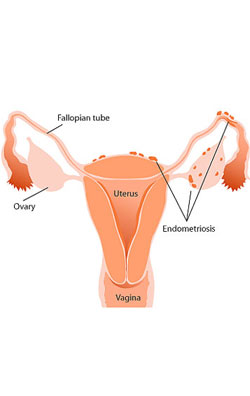
Endometriosis is one of the common gynecological problems in which the endometrium, the innermost tissue of the uterus is present on other lower abdominal (pelvic) organs. Commonly affected organs are the ovaries, the fallopian tubes, the outer walls of the uterus, etc. Rarely endometriosis may occur on organs located outside the pelvic area.
Despite the abnormal location of this normal tissue (ectopic location), endometrium behaves in the same manner it behaves in the uterus. Hence it changes along with its counterpart located inside the uterus leading to cyclical change of the tissue; thickening and then breaking down and bleeding. Unlike bleeding in the uterine cavity, bleeding from these ectopic sites leads to entrapment of blood and the symptoms. In most of the cases adhesive tissues develop among the different organs located in the lower abdominal area. Common presenting symptoms include excruciatingly painful menstruation. Sometimes this disease may affect the reproductive capability of the affected person.
Endometriosis can be successfully treated either by drugs or by surgery.
Symptoms
The most common presenting symptom of endometriosis is pain (usually cramping in nature) in the lower abdominal and lower back area especially during menstruation. The severity of pain varies from person to person; in some the pain can be moderately bothering while in some the pain is excruciating interfering with normal routine. Usually pain is also not related to the extent of the disease as severe pain may occur in women with mild endometriosis.
Other common presenting features of endometriosis include painful intercourse, painful bowel movement, painful urination usually during menstruation, excessive bleeding during menstruation, etc.
Sometimes endometriosis does not produce any significant symptom rather the condition is diagnosed during investigation for other diseases or symptoms like infertility. Other accompanying symptoms include generalized weakness, malaise, bloating, nausea, vomiting, alteration of bowel movement either diarrhea or constipation, etc.
Endometriosis may lead to two types of complications; these are infertility and ovarian cancer.
Infertility is common in about one third to one half of the women suffering from endometriosis. The ovum released by the ovaries travel down the corresponding fallopian tube; here the ovum gets fertilized by the sperm. In endometriosis patients, the fallopian tube is often blocked by the ectopic endometrial tissue thereby hindering fertilization. Sometimes endometriosis may lead to damage of the ovum thus leading to infertility. Although infertility usually does not occur in women with mild to moderate degree of endometriosis, it is usually advised to complete family in these women as early as possible.
As such the risk of ovarian cancer does no increase in endometriosis, however a special type of cancer known as endometriosis associated ovarian cancer may occur in the long run.
Causes
The exact underlying cause of endometriosis is not known however different possible causes are identified; these are
1. Retrograde menstruation characterized by backflow of menstrual blood through the fallopian tubes into the pelvic cavity, entrapment of endometrial cells on the pelvic walls, change in the morphology of these cells throughout the menstrual cycle under hormonal influence and finally bleeding.
2. Growth of embryonic cells: sometimes embryonic cells may persist in the pelvic cavity even in adulthood, which may grow into endometrial cells and result into endometriosis
3. Uterine surgery: following surgical incision on the uterus as after caesarean section the endometrial tissue from the uterine cavity may cling to the site of incision and grow on the outer wall of the uterus
4. Transportation of endometrial cells to distant sites by lymphatic channels may lead to endometriosis
Common risk factors include never getting pregnant, family history of endometriosis, especially in first degree relatives, past history of pelvic infection, abnormality in the uterine structure since birth, suffering from any other conditions which obstruct the normal outflow of menstrual blood etc.
Treatment
Treatment approach depends upon the severity of the presenting symptoms, extent of the disease and desire to conceive in future.
Approaches are
1. Drug therapy: drug therapy include pain killers like NSAIDs, hormone therapy as hormonal contraceptive pills, danazol, medroxyprogesterone, gonadotrophin releasing hormone agonists and antagonists etc.
2. Surgery: conservative approach is adopted in women who want to get pregnant in future and hysterectomy (removal of uterus) is dome in severe cases.





